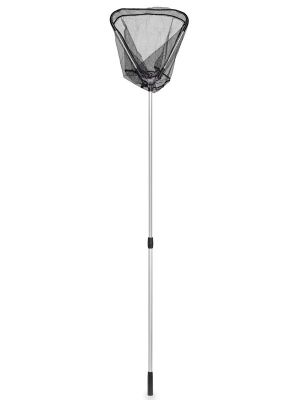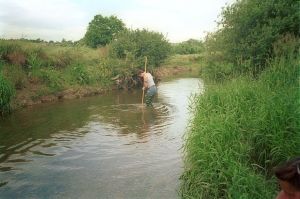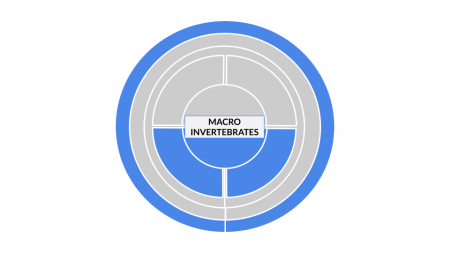Difference between revisions of "Macroinvertebrates"
Oskarlemke (talk | contribs) |
Oskarlemke (talk | contribs) |
||
| Line 49: | Line 49: | ||
Invertebrates are stored in a white tray. The sample can be preserved with 95% ethanol. After determination of the taxa, individual scores are calculated that are based on the tolerance towards oxygen depletion of each taxon. These scores are summed up to produce a biotic score for this section of the river. This score gives an estimate on the oxygen content of the river stretch and therefore, of its water quality. | Invertebrates are stored in a white tray. The sample can be preserved with 95% ethanol. After determination of the taxa, individual scores are calculated that are based on the tolerance towards oxygen depletion of each taxon. These scores are summed up to produce a biotic score for this section of the river. This score gives an estimate on the oxygen content of the river stretch and therefore, of its water quality. | ||
| − | === | + | ===Strengths and Challenges=== |
Kick-sampling is a quick and straight-forward method to collect invertebrates from rivers. Moreover, it is standardized and allows to calculate a score that can be used to estimate the water quality. However, only a small proportion of invertebrates from a streambed are caught, so that it cannot be used to calculate population densities. | Kick-sampling is a quick and straight-forward method to collect invertebrates from rivers. Moreover, it is standardized and allows to calculate a score that can be used to estimate the water quality. However, only a small proportion of invertebrates from a streambed are caught, so that it cannot be used to calculate population densities. | ||
| + | |||
| + | ==Taking benthic cores== | ||
| + | ===What the method does=== | ||
| + | [[File:Fig3 WormsMACROINVERTEBRATES.png|thumb|right|Figure 3. a) Polychaete worm. b) Oligochaete worm. Sources: https://commons.wikimedia.org/wiki/File:Polychaeta_%28no%29_2.jpg https://commons.wikimedia.org/wiki/File:Oligochaeta.jpg]] | ||
| + | Taking benthic cores is a simple way to collect invertebrates such as polychaete and oligochaete worms (Figure 3). | ||
| + | For taking benthic cores, a corer (Figure 4) is sunk into the substrate. If the substrate is firm, the corer is simply pulled from the substrate. If the substrate is soft, a thin piece of metal is slid across the opening of the corer to prevent the sand from falling out. | ||
| + | The same method can be conducted in deep water as well, using a boat. In this case, the corer need to be longer and have a bung that fits tightly into its top end. The corer is pushed into the substrate and the bung is pushed into the top end of the corer. This creates a vacuum that prevents the substrate from falling out. The depth of the corer should be around 10 to 15 cm for a sample of 5 cm depth. The corer is then pulled out of the substrate. The benthos is then slowly removed from the corer to not injure the invertebrates. The unwanted part of the sample can be discarded now. | ||
| + | Afterwards, invertebrates are extracted by wet sieving with meshes of e.g. the sizes 2 mm, 1 mm and 0.5 mm for invertebrates of down to 1 mm length. To make the sorting process quicker and more efficient, a 1% solution of Rose Bengal dye might be added to stain the translucent invertebrates pink. If the sorting process should take place later on, the sample can be preserved with 95% ethanol. | ||
| + | |||
| + | ===Strengths and Challenges=== | ||
| + | In general, this is a relatively quick and easy method to sample benthos. However, sampling in deep water is more challenging as a boat is needed.In this case, the main challenge is to steer the boat into the correct position. | ||
---- | ---- | ||
Revision as of 14:35, 18 April 2023
| Method categorization | ||
|---|---|---|
| Quantitative | Qualitative | |
| Inductive | Deductive | |
| Individual | System | Global |
| Past | Present | Future |
In short: Netting, kick sampling and taking benthic cores are methods for collecting macroinvertebrate samples to obtain information about the water quality of a river, lake or pond.
| Netting | Kick sampling | Taking benthic cores | |
| Zone | nekton | riffles in nekton | benthal |
| Speed of water | slow | fast-flowing | still or slow-moving |
| Depth of water | shallow (pond nets), deep (tow nets) | shallow | shallow/ deep (using a boat) |
Netting
What the method does

To standardize pond netting to enable comparisons between different sites or different times at the same site, two points in the water are marked with canes and the net is moved in between the poles for a certain number of times at a constant speed. After netting, the net is emptied into a white tray such as a photographic developing tray. The net should be washed very carefully to remove all the specimens. Some specimens such as nymphs often strongly cling to the net. For tow netting, a net is pulled behind a driving boat to estimate the number of zooplankton in open water. While driving the boat, it is important to keep the opening of the net perpendicular to the water surface to keep the opening of the net at the same size throughout each tow. To measure the distance of towing, it is helpful to add a flowmeter to the net. After towing, the content of the collecting bottle is emptied into a container. To wash off all the zooplankton from the inside of the net, water is splashed from the outside. It can take a considerable amount of time to transfer all the invertebrates from the net into the container. The sample is preserved with 95% ethanol.
Strengths and Challenges
Pond nets can be used for quick surveys of the species that occur in a pond or stream. Within only three minutes of netting, you can find 62% of families and 50% of species that you can catch during 18 minutes of netting (Furse et al. 1981). However, this method is hard to standardize as the net-hauls always need to have the same length and the same speed and these are hard to keep up. This means that this method can be used to get an overview on the number of species, but not to compare species richness and abundances between different sites or points in time. Tow nets can be used in deep, open and weed-free waters. They are suitable for large areas of water, especially for watching zooplankton as this is often distributed in patches. They require more work as at least two people are needed, of which one steers the boat and the other one looks after the net. A major problem is to drive the boat with constant speed to standardize the method. Moreover, turbulence caused by the boat might disturb the position of the net. The nets can become clogged by sediment and phytoplankton, so that they lose their catching efficiency.
Kick sampling
What the method does

Kick sampling is a method that is applied to collect invertebrates from fast-flowing streams, especially from riffles, to assess the water quality. Therefore, a net is held on the ground of the river with its opening facing towards the water flow direction. The substrate is disturbed by kicking and the invertebrates are dislodged and collected in the net a short distance downstream (Figure 2).
The standardized version of this method consists of sampling all the micro-habitats within a stretch of a stream by kick-sampling for a total of three minutes by using a 0.9-mm-mesh pond net. Invertebrates are stored in a white tray. The sample can be preserved with 95% ethanol. After determination of the taxa, individual scores are calculated that are based on the tolerance towards oxygen depletion of each taxon. These scores are summed up to produce a biotic score for this section of the river. This score gives an estimate on the oxygen content of the river stretch and therefore, of its water quality.
Strengths and Challenges
Kick-sampling is a quick and straight-forward method to collect invertebrates from rivers. Moreover, it is standardized and allows to calculate a score that can be used to estimate the water quality. However, only a small proportion of invertebrates from a streambed are caught, so that it cannot be used to calculate population densities.
Taking benthic cores
What the method does

Taking benthic cores is a simple way to collect invertebrates such as polychaete and oligochaete worms (Figure 3). For taking benthic cores, a corer (Figure 4) is sunk into the substrate. If the substrate is firm, the corer is simply pulled from the substrate. If the substrate is soft, a thin piece of metal is slid across the opening of the corer to prevent the sand from falling out. The same method can be conducted in deep water as well, using a boat. In this case, the corer need to be longer and have a bung that fits tightly into its top end. The corer is pushed into the substrate and the bung is pushed into the top end of the corer. This creates a vacuum that prevents the substrate from falling out. The depth of the corer should be around 10 to 15 cm for a sample of 5 cm depth. The corer is then pulled out of the substrate. The benthos is then slowly removed from the corer to not injure the invertebrates. The unwanted part of the sample can be discarded now. Afterwards, invertebrates are extracted by wet sieving with meshes of e.g. the sizes 2 mm, 1 mm and 0.5 mm for invertebrates of down to 1 mm length. To make the sorting process quicker and more efficient, a 1% solution of Rose Bengal dye might be added to stain the translucent invertebrates pink. If the sorting process should take place later on, the sample can be preserved with 95% ethanol.
Strengths and Challenges
In general, this is a relatively quick and easy method to sample benthos. However, sampling in deep water is more challenging as a boat is needed.In this case, the main challenge is to steer the boat into the correct position.
The author of this entry is Anna-Lena Rau.
